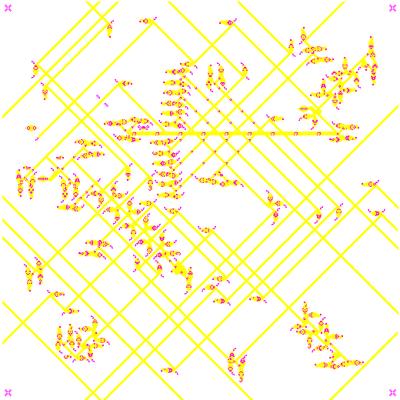As it turns out, the timing guns in David Bell's original 500x500 Unit Life Cell are a good bit slower than they need to be, so there's still plenty of time for signals to arrive from neighboring 512-size cells, even though they have a little farther to travel. So the biggest headache was resynchronizing a lot of p30 circuitry; stretching each unitcell by 12 cells added multiples of 48 ticks to the glider paths. [If only the magic number had been 515 instead of 512, I would hardly have had to resynchronize anything at all...]
 The "circuit diagram" for the original Unit Life Cell is shown at right: the area is 499^2 cells (and you need a one-cell-wide space between adjacent cells).
The "circuit diagram" for the original Unit Life Cell is shown at right: the area is 499^2 cells (and you need a one-cell-wide space between adjacent cells).I didn't include a trail for the reaction for an OFF cell with two neighbors, which makes use of the isolated pentadecathlon at the left -- the #2 neighbor-count glider bounces back and annihilates what would otherwise be the ON output glider generated by the #3 neighbor-count glider. (I think.)
I had to make surprisingly few changes to expand the above to a 511^2 cell -- basically, just a gun and a few reflectors in the lower left corner had to be moved southwest, and then the gun, the counting chute, and all the reflectors leading to it needed to be rephased to match the new timing of the gliders from neighboring cells.
Here's the RLE for a single 511^2 Unit Life Cell.
-- And here's the RLE for a 3x3 test grid representing a blinker, with the Xlife version here.
Coincidentally, I had to switch to RLE in the unitcell #B definition -- it looks like the current version of Xlife can't quite handle picture-format subpatterns at width 512, so my 3x3 grid was getting corrupted. I included the #M prefix in the RLE header, so Achim's Xlife 3.6 should be able to handle the above pattern. I have a private build (3.5.2. going on 3.5.3) that can handle RLE subpatterns with or without the non-standard Xlife-style #M tags, but that change hasn't spread very far yet...
------------------------------------
It wouldn't be an impossibly difficult task to adjust the unitcell period to be a power of 2 as well: after David Bell designed and built the original Unit Life Cell, a p8N glider reflector was discovered, comparable in size to the p30N reflector used in the current unitcell. (Unlike p30, p8 would be compatible with power-of-two step sizes between generations, which would match the way Golly's underlying 'hlife' algorithm works with Life patterns.]
However, so far I am successfully resisting that project: since the fanout device and the glider-to-block converters (and the rest of the neighbor-counting logic) are irrecoverably p30, they'd all have to be replaced with p8 equivalents -- and offhand I don't know of a p8 glider-to-block converter or a small alternate glider reflector equivalent to the two-p30-gun reflector used to get gliders onto the other square color. Easy enough to arrange a new Herschel-based fanout device so no alternate reflectors are needed, though --
Rather than work on a p8-reflector-based version, I'd be tempted to find a pure-stable solution: the advantage would be that any cells that are not ON have no moving parts whatsoever! Which would probably increase the simulation speed, and might also make it easier to see the active cells in a large pattern of unitcells. I think I have all the pieces for a pure-stable Unit Life Cell worked out in my head now (see the next posting)... and they are even easy to reconfigure for any standard rule. Well, any non-B0 rule at least -- otherwise I need a clock gun in each cell.
No comments:
Post a Comment